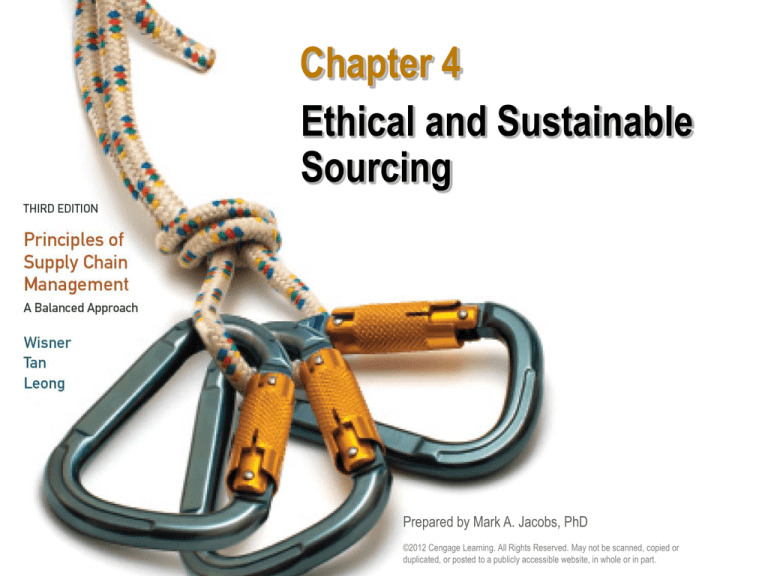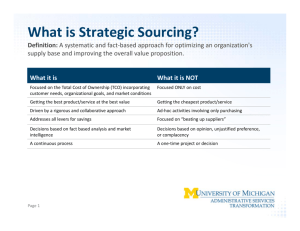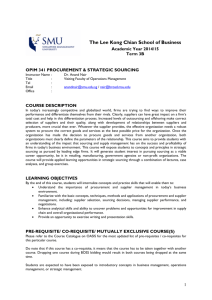
Chapter 4
Ethical and Sustainable
Sourcing
Prepared by Mark A. Jacobs, PhD
©2012 Cengage Learning. All Rights Reserved. May not be scanned, copied or
duplicated, or posted to a publicly accessible website, in whole or in part.
LEARNING OBJECTIVES
You should be able to –
• Describe the difference between purchasing and
strategic sourcing
• Describe how strategic sourcing plans are developed and
implemented
• Define and describe the terms green sourcing, VMI, JIT
II, in-sourcing, co-sourcing, and co-managed inventories
• Describe sourcing’s role in managing key supplier
relationships
©2012 Cengage Learning. All Rights Reserved. May not be scanned, copied or duplicated, or posted to a publicly accessible website, in whole or in part.
2
LEARNING OBJECTIVES
(Continued)
You should be able to –
• Describe the performance criteria used in assessing
suppliers.
• Describe how strategic supplier relationships can impact
the firm.
• Describe how a reverse auction works.
• Understand the importance of sharing the benefits of
strategic partnerships.
• Understand the strategic role played by the purchasing
function in developing & improving the supply chain.
©2012 Cengage Learning. All Rights Reserved. May not be scanned, copied or duplicated, or posted to a publicly accessible website, in whole or in part.
3
CHAPTER OUTLINE
• Introduction
•
•
•
•
•
•
•
Ethical and Sustainable Sourcing
Developing Ethical and Sustainable Sourcing Strategies
Supply Base Rationalization Programs
Ethical and Sustainable Supplier Certification Programs
Outsourcing Products & Services
Early Supplier Involvement
Strategic Alliance Development
©2012 Cengage Learning. All Rights Reserved. May not be scanned, copied or duplicated, or posted to a publicly accessible website, in whole or in part.
4
CHAPTER OUTLINE
•
•
•
•
(Continued)
Use of e-Procurement Systems
Rewarding Supplier Performance
Benchmarking Successful Sourcing Practices
Using Third-Party Supply Chain Management Services
• Assessing & Improving the Firm’s Sourcing Function
©2012 Cengage Learning. All Rights Reserved. May not be scanned, copied or duplicated, or posted to a publicly accessible website, in whole or in part.
5
Introduction
Sourcing - all of firm’s activities used to manage
external resources.
Strategic sourcing - managing the firm’s external
resources to support firm’s long term goals.
Drivers of Strategic Sourcing
Reduce costs & delivery cycle times
Improve quality & long-term financial performance
Increase number of global competitors
Increase customer focus
Reduce high costs of globalization & materials,
Deliver more innovative products more frequently &
cheaply than competitors
Ethical and Sustainable Sourcing
Strategies
Business Ethics is the application of ethical
principles to business
Corporate Social Responsibility is the practice
of business ethics
Ethical Sourcing is that which attempts to take into
account the public consequences of organizational
buying or bring about positive social change through
organizational buying behavior
Ethical and Sustainable Sourcing
Strategies
(Continued)
Ethical Policies should include –
Determining where all purchased goods originated
and the manner in which they were made
Knowledge of the suppliers’ workplace principles
Inclusion of ethics as a performance rating
Independent verification of vendor compliance
Report of supplier compliance to stakeholders
Provision of detailed ethical sourcing expectations to
suppliers
Ethical and Sustainable Sourcing
Strategies
(Continued)
Sustainable Sourcing
Green purchasing is aimed at ensuring products or
materials meet environmental objectives e.g. waste
reduction, reuse and recycling
Sustainability is the ability to meet current needs of
the supply chain without hindering the ability to meet
future needs in terms of economic, environmental,
and social challenges
Considers worker safety, wages, working conditions, human
rights
Ethical and Sustainable Sourcing
Strategies
(Continued)
Sustainable Sourcing should seek to –
Grow revenues
New sustainable product introduction
Reduce costs
Increase resource efficiencies
Manage risk
Link brand to social consciousness of consumer
Build intangible assets
Build social and environmental responsibility
Ethical and Sustainable Sourcing
Strategies
(Continued)
Functional Products - MRO items & other
commonly low profit margins with relatively stable
demands & high levels of competition
Innovative Products - characterized by short
product life cycles, volatile demand, high profit
margins, & relatively less competition
Ethical and Sustainable Sourcing
Strategies
(Continued)
Framework for ethical and sustainable
sourcing strategy development –
Step 1 – Establish corporate ethical and sustainable sourcing
strategies
Step 2 – Train purchasing staff and implement policies
Step 3 – Prioritize items based upon ethical and sustainability
opportunities and ease of implementation
Step 4 – Develop performance measurement system
Step 5 – Monitor progress and make improvements. Increase use
of green and fair trade products
Step 6 – Expand focus to include other departments
Ethical and Sustainable Sourcing
Strategies
(Continued)
Ethical and Sustainable Framework
Step 1:
Establish
policies
Step 2: Train and
implement
Step 3:
Prioritize
opportunities
Step 4: Develop
performance
measurement
systems
Step 5: Monitor
progress and
make
improvements
Step 6: Expand
focus to other
departments
Supply Base Rationalization
Programs
Supply base rationalization (AKA supply base
reduction or supply base optimization) is often
the initial supply chain management effort
Buyer-supplier partnerships are easier with a
rationalized supply base & result in –
Reduced purchase prices
Fewer supplier management problems
Closer & more frequent interaction between buyer &
supplier
Greater levels of quality & delivery reliability
Ethical and Sustainable Supplier
Certification Programs
Supplier certification programs are used to
identify strategic supplier alliance candidates
Firms use in-house formal certification programs,
& most require ISO 9000 / 14000 or similar
certifications as part of the certification process
Buyers can monitor quality assurance methods &
specify the type of acceptance sampling &
statistical process control methods used
Outsourcing Products and
Services
Outsourcing allows a firm to –
Concentrate on core capabilities
Reduce staffing levels
Accelerate reengineering efforts
Reduce management problems
Improve manufacturing flexibility.
Risks associated with outsourcing, include –
Loss of control
Production decisions & intellectual property
Increased reliance on suppliers
Increased need for supplier management
Outsourcing Products and
Services
(Continued)
In-sourcing (backsourcing) –
Reverting to in-house production when quality, delivery,
and services do not meet expectations
Co-sourcing (selective sourcing) –
The sharing of a process or function between internal
staff and an external provider & provides flexibility to
decide what areas to outsource, when, and for how
long.
Early Supplier Involvement
Early supplier involvement (ESI) highly effective
supply chain integrative techniques
- Key suppliers become more involved in the internal
operations of the firm, particularly with respect to
new product & process design, concurrent
engineering & design for manufacturability
techniques
Value engineering activities help the firm to reduce
cost, improve quality & reduce new product development
time
Early Supplier Involvement
(Continued)
Vendor managed inventory (VMI) –
Suppliers manage buyer inventories to reduce inventory
carrying costs & avoid stockouts for buyer
From the buyer-firm’s perspective –
Supplier tracks inventories
Determines delivery schedules and order quantities
Buyer can take ownership at stocking location
From the supplier’s perspective –
Avoids ill-advised customer orders
Supplier decides inventory set up & shipments
Opportunity for supplier to educate customers about other
products
Early Supplier Involvement
(Continued)
Electronic data interchange (EDI)
Allows a supplier to profile demand & determine accurate
forecasts
EDI also provides reorder point data to permit timely
deliveries
Supplier co-location or JIT II
Supplier’s employee is embedded in buyer’s purchasing
department to forecast demand, monitor inventory & place
orders with access to sensitive files & records
Strategic Alliance Development
Alliance development, an extension of supplier
development refers to increasing a key or
strategic supplier’s capabilities.
Supplier alliances result in better market
penetration access to new technologies &
knowledge, & higher return on investment
Alliance development eventually extends to a
firm’s second-tier suppliers, as the firm’s key
suppliers begin to form their own alliances.
Negotiating Win-Win Strategic
Alliance Agreements
Collaborative negotiations (aka integrative
negotiations) –
Both sides work together to maximize the outcome
or create a win-win result
Requires open discussions and a free-flow of
information between parties
Distributive negotiations –
Refers to a process that leads to self-interested,
one-sided outcome
Negotiating Win-Win Strategic
Alliance Agreements
(Continued)
Steps
Description
1. Build preparation
process
Gain an understanding of both parties’ interests;
brainstorm value-maximizing solutions; identify objective
criteria to evaluate fairness of agreement.
2. Develop
negotiation
database
Review previous negotiations to catalogue standards,
practices, precedents, metrics, creative solutions used,
and lessons learned.
3. Design
negotiation
launch process
Create an environment to work together to create a
shared vocabulary, build working relationships, and map
out a shared decision-making process.
4. Institute feedback
mechanism
Create process to provide feedback to negotiating teams
and capture lessons learned.
(Table 4.4)
Use of e-Procurement Systems
Primary benefits of e-procurement include –
Cost savings
Frees-up time to concentrate on core business
e-procurement systems –
Concentrate large volumes of small purchases with
a few suppliers, using e- catalogues, available to
the organization’s users.
Reverse auctions –
Pre-qualified suppliers enter Web site & at predesignated time & date, try to underbid competitors,
monitoring bid prices until the session is over.
Rewarding Supplier Performance
Rewarding suppliers provides an incentive to surpass
performance goals
Punishment is a negative reward, may be to reduce
future business; or a bill-back amount equal to the
incremental costs resulting from a late delivery or poor
quality
Strategic supplier agreements can reward
suppliers by allowing –
A share of the cost reductions
More business and/or longer contracts
Access to in-house training seminars & other resources
Company & public recognition
Benchmarking Successful
Sourcing Practices
Benchmarking –
Measuring what other businesses do best and
matching their performance is an effective approach
to improving supply chain performance.
Benchmarking data regarding sourcing practices can
be obtained in any number of ways, both formal &
informal.
Resources for learning about & implementing
sourcing practices –
The Center for Advanced Purchasing Studies.
Supply-Chain Council.
Using Third-Party Supply Chain
Management Services
Third-party logistics (3PL)
A growing industry that involves managing a
firm’s sourcing or materials &/or product distribution
responsibilities
3PL providers charge a fee for services for an estimated
savings of 10 to 20% of total logistics costs; benefits
include improved service, quality, & profits for their
clients.
Vendor-managed inventory (VMI) services –
One of the more popular roles of 3PL.
Lead logistics provider (LLP), aka 4PL –
A primary 3PL provider; one that oversees other
3PL’s
Assessing & Improving the Firm’s
Purchasing Function
The purchasing function is one of the most
value-enhancing functions in any organization
It is preferable to periodically monitor the
purchasing function’s performance against set
standards, goals, and/or industry benchmarks.
Surveys or audits can be administered as selfassessments among purchasing staff as part of the
annual evaluation process.
Assessing & Improving Firm’s
Purchasing Function
(Continued)
Skill set requirements of purchasing professionals
have been changing. Purchasing personnel must today
exhibit world-class skills such as –
1. Interpersonal
communication
2. Ability to make
decisions
3. Ability to work in
teams
4. Analytical skills
5. Negotiation skills
6. Customer focus
7. Ability to manage
change
8. Influencing &
persuasion skills
9. Strategic skills
10. Understanding
business conditions
Assessing & Improving Firm’s
Purchasing Function
(Continued)
Assessment criteria include –
1. Participating in and
leading
multifunctional teams
2. Participate in value
engineering efforts
3. Optimize supply
base
4. Create ESI initiatives
5. Utilize e-procurement
6. Further supplier
integration
7. Contribute to new
product development
8. Improve time to
market
9. Initiate supplier cost
reduction programs
10. Creation of strategic
alliances







